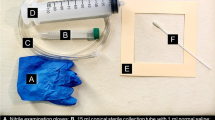Abstract
In the summer of 2010, parenteral nutrition (PN) admixtures were administered to neonates in the Pediatric Department of the University Medical Center Mainz that provoked severe clinical sequelae. Contamination of a dummy infusion with Enterobacter cloacae and Escherichia hermannii was detected on the day of the incident, and the same isolates were subsequently grown from all PN admixtures as well as from the parent amino acid solution from which the admixtures had been prepared. Quantitative microbiological analyses paired with the determination of endotoxin concentrations enabled the conclusion to be reached that the amino acid solution had represented the primary source of contamination, which must have occurred in the distant past and may have derived from passage of the bacteria through a crack in the glass container. The findings have large implications, and the approaches employed should become of value when similar incidents occur again in the future.



Similar content being viewed by others
References
Jarvis WR, Highsmith AK, Allen JR, Haley RW (1983) Polymicrobial bacteremia associated with lipid emulsion in a neonatal intensive care unit. Pediatr Infect Dis 2:203–208
Langford SA (1999) Mortality and morbidity from the in-use microbial contamination of intravenous products. Hospital Pharm 6:104–109
Sack RA (1970) Epidemic of gram-negative organism septicemia subsequent to elective operation. Am J Obstet Gynecol 107:394–399
Daisy JA, Abrutyn EA, MacGregor RR (1979) Inadvertent administration of intravenous fluids contaminated with fungus. Ann Intern Med 91:563–565
Wang SA, Tokars JI, Bianchine PJ, Carson LA, Arduino MJ, Smith AL, Hansen NC, Fitzgerald EA, Epstein JS, Jarvis WR (2000) Enterobacter cloacae bloodstream infections traced to contaminated human albumin. Clin Infect Dis 30:35–40
Dalben M, Varkulja G, Basso M, Krebs VL, Gibelli MA, van der Heijden I, Rossi F, Duboc G, Levin AS, Costa SF (2008) Investigation of an outbreak of Enterobacter cloacae in a neonatal unit and review of the literature. J Hosp Infect 70:7–14
van den Berg RW, Claahsen HL, Niessen M, Muytjens HL, Liem K, Voss A (2000) Enterobacter cloacae outbreak in the NICU related to disinfected thermometers. J Hosp Infect 45:29–34
Lacey SL, Want SV (1995) An outbreak of Enterobacter cloacae associated with contamination of a blood gas machine. J Infect 30:223–226
Matsaniotis NS, Syriopoulou VP, Theodoridou MC, Tzanetou KG, Mostrou GI (1984) Enterobacter sepsis in infants and children due to contaminated intravenous fluids. Infect Control 5:471–477
Tresoldi AT, Padoveze MC, Trabasso P, Veiga JF, Marba ST, von Nowakonski A, Branchini ML (2000) Enterobacter cloacae sepsis outbreak in a newborn unit caused by contaminated total parenteral nutrition solution. Am J Infect Control 28:258–261
Cousins DH, Upton DR (1995) Are aseptic dispensing services risky? Pharm Pract 5:227
Acknowledgments
We thank Susanne Teske-Keiser for excellent technical assistance.
Author information
Authors and Affiliations
Corresponding author
Additional information
Sucharit Bhakdi and Irene Krämer contributed equally.
Rights and permissions
About this article
Cite this article
Bhakdi, S., Krämer, I., Siegel, E. et al. Use of quantitative microbiological analyses to trace origin of contamination of parenteral nutrition solutions. Med Microbiol Immunol 201, 231–237 (2012). https://doi.org/10.1007/s00430-012-0236-3
Received:
Accepted:
Published:
Issue Date:
DOI: https://doi.org/10.1007/s00430-012-0236-3




